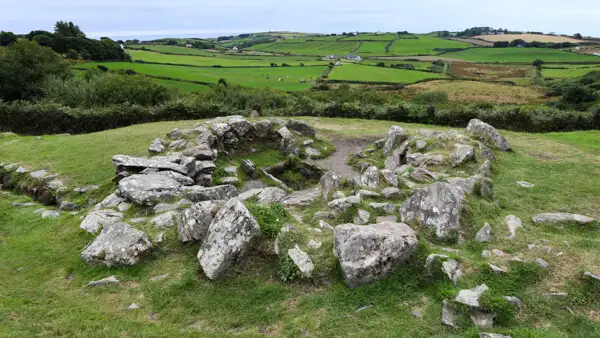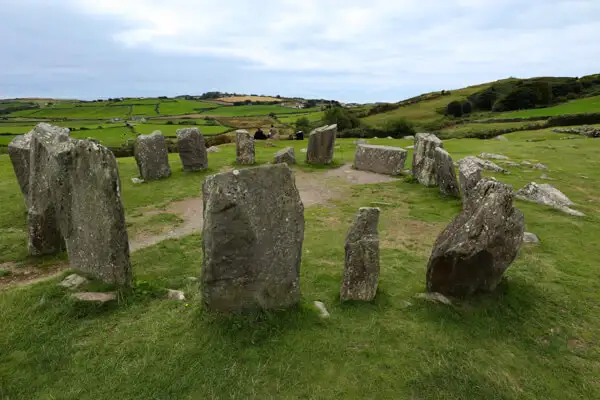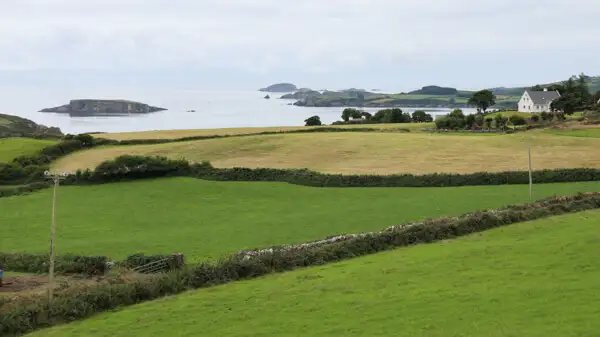Für Steinkreise interessieren sich wahrscheinlich zwei Besuchergruppen besonders: Menschen, die ein allgemeines Interesse and der Geschichte eines Landes haben und Menschen, die sich besonders für Mythologie interessieren.
Aber welcher Gruppe du auch angehörst, wenn du Irland besuchst, solltest du den Drombeg Stone Circle unbedingt in deine Tour einplanen…
Page Contents (click line to jump the text)

Intro
I’m not a mythological person at all, but special places have a special effect on me too. I consciously take notice of them, like to spend some time there and let the place have an effect on me.
The “magic” of the place obviously has an effect on many people and so it is not surprising that such special places have always been used by people as ritual and cultural sites.
The stone circle of Drombeg on the south coast of Ireland is one such place.
It is a rather small and inconspicuous place, off the beaten track.
On a motorbike tour, I happened to notice a small signpost. As I wasn’t in a hurry, I simply followed it. The small car park only holds a few vehicles, but somehow a motorbike still fits in.
Helmet in hand, I stroll along the small path without any expectations – the most beautiful way to travel.
An information board tells me about the stone circle. I walk round the stone circle several times, take a few photos – and then a few more. A deep and contented calm lies over the scenery – the few other visitors seem anything but stressed.
The landscape is a dream. I love the Irish “rolling hills”, the hilly landscapes with their pastures and small farmsteads. In the background, I can see the sea merging with the blue-grey horizon.
Sitting on a small hill, I let my gaze wander over the stone circle into the distance and savour the wonderful scene for a while before I set off again and follow the cove-rich, rugged coast to the west…
My family and I are from Germany, but live (second home) in Ireland. We have travelled the island many times and know it quite well.
What we know about the Drombeg Stone Circle today
Long before the advent of Christianity, people celebrated their rituals and festivals here, the significance of which we can only speculate about today.
The cult site is several thousand years old. In any case, the skeleton of a male youth that was excavated here has been dated to an age of around 3000 years. The stone circle is probably much older.
Was this a Celtic place of worship? According to previous opinion, the Celts only arrived in Ireland from France around 600 BC as part of the migration of peoples. However, many of the dolmens, menhirs, ring circles and settlement finds in Ireland are several thousand years older. There was probably a late Stone Age and early Bronze Age population in Ireland long before the Celts, who built places of worship made of stone – a megalithic culture, which can also be found particularly on the north coast of Spain or in Brittany (“menhirs”).
“Pagan” festivals were often organised according to an astronomical calendar and coincided, for example, with the winter solstice or summer solstice.

When you enter the Stone Circle via the two portal tombs, the portal stones that are almost two metres high, you look over a flat stone to the south-west, in the direction of the winter solstice. The alignment is not entirely precise today, possibly due to the shift in the Earth’s axis of rotation over the millennia. In the past, the alignment was probably very precise.
Incidentally, the stone circle consists of a total of 17 stones. The flat stone opposite the portal stones is now referred to as a sacrificial stone, but whether it had this role and whether the skeleton was a sacrifice is not entirely clear.
It is likely, however, that the megalithic cultures knew of druids long before the Celts, who held ritual ceremonies in this stone circle (and others).
Druids were probably primarily priests and responsible for connecting the human world with the religious world. They were the keepers of the stories and religion of their people, which were mainly passed on orally. It is also likely that they knew nature, the stars and the healing powers of plants better than other people and also taught and passed on this knowledge orally from generation to generation among the Druids.
Mythology of the stones
A purely scientific examination of the Drombeg stone circle, or of megalithic cultures in general, can sometimes be somewhat boring.
This is probably due to the fact that we can hardly find out how people really lived 5000 years ago, let alone what their spiritual life was like.
Stories and history were simply not written down back then and the oral transmission of ancient knowledge was largely forgotten in more recent history with Christianisation and the Enlightenment.
But in myths, fairy tales and legends, traces of ancient knowledge, or beliefs, have survived the ages much better.
The Irish love a well-told story and Ireland is a land of myths: of course, magical rituals with animal and human sacrifices took place at the Drombeg Stone Circle. And yes, druids naturally have magical powers. It was a dark and evil place full of suffering and the Banshee (Banshee) always signalled the imminent death of a person with shrill cries.
Well, I can’t and don’t want to judge that. But I found the place to be really beautiful and (almost meditatively) quiet.

Visit the Drombeg Stone Circle
Seek and ye shall find – the stone circle is almost only found by those who seek it – or end up there by chance, as I did. The small village nestles inconspicuously in the hilly landscape on the south coast of Ireland. These coasts are already part of the Wild Atlantic Way, but many travellers drive from Cork on the N71 towards Skibbereen and the west coast without visiting the south coast.
Treat yourself to the little adventure of turning off the N71 a couple of times and driving along the small bays directly on the coast, for example on the R597 from Rosscarbery to Leap. The coastal landscapes are beautiful and you’ll find some hidden gems here, such as the Drombeg Stone Circle. On the R597, you’ll find a few small signs directing you to the Drombeg Stone Circle.

What else can you do in the region?
If you continue along the R597, you will come to Glandore. The small and very pretty harbour nestles deep into the bay, while the small road follows the coast in many bends.
Castletownshend Bay is also worth a visit, as is Knockdrum Stone Fort nearby or Toe Head a little further on. See:
At Reen Pier, in the sheltered bay of Castletownhend, you can take a kayak tour, see: https://www.atlanticseakayaking.com/.
The region is also a hotspot for whale-watching, i.e. boat tours to observe whales and dolphins and other marine life. You will also find Cork Whale Watch at Reen Pier, see: https://corkwhalewatch.com/.
If you follow the coast further west, you will come to Baltimore, a very pretty holiday resort and former fishing harbour in a beautiful long bay with picturesque offshore islands

Conclusion
The (west) south coast of Ireland offers many beautiful hidden coves, hilly hinterland and rural tranquillity. Although it is already part of the Wild Atlantic Way, there is much less tourism here than on the west coast.
The hills and bays are dotted with historic gems, old lighthouses, an old castle that once offered protection to a clan and is little more than a square tower and historic sites such as the Drombeg Stone Circle or the Knockdrum Stone Fort.
Turn off the national road and meander along the little-known south coast – you’ll love it!
More interesting articles for you
GLENDALOUGH MONASTIC CITY – A MUST-SEE-PLACE IN IRELAND’S ANCIENT EAST!
HOOK HEAD LIGHTHOUSE – THE OLDEST ACTIVE LIGHTHOUSE IN THE WORLD
BLARNEY CASTLE AND THE STONE OF ELOQUENCE
WATERFORD AND THE VIKINGS
Picture credits cover picture: The Drombeg Stone Circle and surroundings, photo: Ulrich Knüppel-Gertberg (www.irland-insider.de, www.ireland-insider.com)